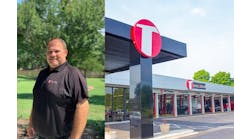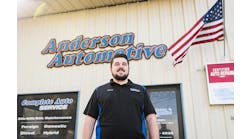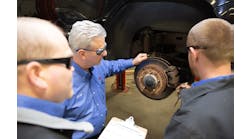For many vehicle owners, says Vic Portincaso, their vehicles are their “lifeblood.” That can make car trouble confusing and frustrating.
“If something goes wrong and you need a tow truck, then you lose a day of work,” he says. “If you can’t get to work, you can’t make money.”
And that experience is only worsened when they get to a repair shop and find they have no idea what the service advisor is recommending.
“A lot of people sit there and listen to you and go, ‘Well sure, I guess he’s the expert,’” he says.
That type of reaction was exactly what Portincaso wanted to avoid when he took over Boss Automotive in Elgin, Ill., eight years ago.
“We take a lot of pride in the fact that we try to attract customers that are looking for very good service, a place where they come in and we know who they are, we know exactly what is going on with their car and they can trust that when we tell them what’s going on, that that’s true,” he says. “To build that trust, we educate our customer.”
BOSS AUTOMOTIVE
LOCATION: ELGIN, ILL.
SIZE: 8,000 SQUARE FEET
STAFF: 7 (5 EMPLOYEES ON THE FLOOR AND 2 EMPLOYEES IN THE OFFICE)
AVERAGE MONTHLY CAR COUNT: 120
ANNUAL REVENUE: $850,000
Portincaso has used that philosophy to not only build better and stronger relationships with customers, but also take a pre-existing shop that was bleeding money and hovering at a negative-10 percent gross profit margin into a profitable, $850,000-per-year business with a 90 percent customer retention rate.
BACKGROUND
Portincaso says the decision to own an auto repair shop was a natural one. After working on the car parts manufacturing side as an engineer for 37 years, Portincaso, his wife, Sandy, and son, Chris, decided they wanted to start a family business. Sandy had experience working on the administrative side of businesses, while Chris had gone to school to become a technician.
Portincaso got to work looking for existing businesses and when he came across Boss Automotive, he says it ticked off nearly every one of the family’s requirements: The shop worked on both collision and mechanical (roughly 80 percent of the work was collision at the time), the business had a catchy name, it was in a desirable location with moderate traffic, and it was owned by a tech with a solid reputation.
THE PROBLEM
The problem, Portincaso says, was that although the shop’s owner was a good tech, he wasn’t a particularly savvy businessman.
Thankfully, none of the problems were a surprise for Portincaso. From the beginning, he worked with an accountant and broker to make sure he knew exactly what he was getting into by purchasing the business. And the reality wasn’t pleasant: The shop’s gross profit margins were at negative- 10 percent and the finances were in shambles.
The real problem, he says, was that the shop had a poor reputation. Car count was low and the shop had difficulty selling jobs.
“They just were not very good at customer service,” Portincaso says. “Customers are expecting you to be the expert. They’re also expecting me to explain it to them so they understand it. They didn’t get that.”
Portincaso realized that even if he solved the gross profit problems, if he couldn’t get customers through the door and sell the jobs, the shop had no chance of survival.
THE SOLUTION
After purchasing the company, Portincaso got to work putting out the obvious fires. He started using QuickBooks to track inventory and expenses, which Portincaso says were very high for the amount of work being brought in. He also started working with a consulting company to make sure the shop was charging enough and getting paid for what they were doing.
After stabilizing the business, however, Portincaso says that what made the biggest difference in restoring the reputation and increasing car count was a change in philosophy by emphasizing an educational approach to customer service.
“After we built the company up a little bit, we were then at the point where we had fixed all the holes and we were doing OK but we wanted to grow the business. We focused most on customer service, and we based a lot of everything that we did on education and educating our customers,” he says. “We started to go after repeat customers. We started working on that to build more of a trust and a financial base.”
The shop started emphasizing 30-point inspection checks for every job and Portincaso started training service advisors to set aside more time to spend with customers. During that time, he trained his staff to help customers prioritize work (dividing it into safety, maintenance and future repair items), and not only explaining the reason behind the repair, but also why it is necessary.
“What I will do is explain what it does on your car and I will explain to you exactly what would happen if this thing failed. Why am I recommending this to you that it has to be taken care of right now?” he says. “They’re expecting me to be an expert. They’re also expecting me to explain it to them so they can understand.”
THE AFTERMATH
For Portincaso, the aftermath has been dramatic: The shop’s revenue climbed from $280,000 to $850,000 in eight years, and gross profit margins rose from that negative-10 percent figure to 40 percent. For that, the shop was awarded the Automotive Training Institute (ATI) “most improved gross profit margin” award in 2015.
The shop has also turned around its mechanical repair side of the shop so that it now accounts for 60 percent of the business. That turnaround has been largely because of the improvement in technician productivity, which is now above 80 percent and has seen each of the five technicians averaging five completed jobs per day (compared to the one per day before).
More than anything, though, Portincaso says that focusing on education and going after referrals and repeat customers has made the largest difference in the business. The shop now has a retention rate of 90 percent and gets roughly 15 new customers a month from referrals only.
“That alone has built our business faster than any kind of advertising,” he says. “That’s a drastic improvement.”
THE TAKEAWAY
Portincaso says that of the numerous takeaways, the biggest was the importance of tracking. Without doing so, he says, he never would have been able to get the shop’s dismal numbers up.
“That’s the biggest downfall of most small repair shops: They do not understand that they need to get paid for what it is that they do,” he says. “We started drilling down more into the individual costs—cost of parts, cost of shop supplies. You start breaking everything up to make sure you’re not buying more for the shop than you need.”
And when it comes to educating customers, Portincaso says that although it sounds fairly simple, it’s a unique skill that you need to be conscious of when hiring.
Over the years, he says he has made it a priority to hire employees who have a warm personality, are personable and enjoy talking to customers.



